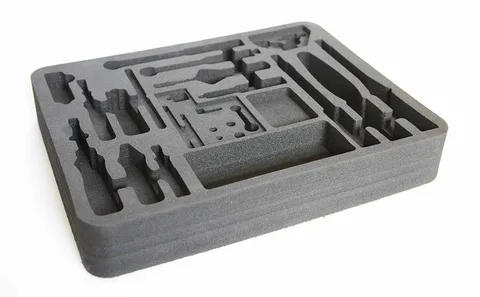Introduction
In the world of packaging and protection, Custom Foam Inserts in the USA have become a go-to solution for industries ranging from electronics to luxury retail. These inserts are not just about aesthetics—they’re about precision, protection, and performance. Whether you’re a business owner shipping delicate instruments or a craftsman creating beautiful display boxes, selecting the right foam insert can make or break your final product experience.
Why Custom Foam Inserts Matter
Protecting Valuable Products
Foam inserts are more than fillers. They are engineered to absorb shocks, resist compression, and maintain product integrity during transit. From fragile glassware to sensitive electronics, a tailored foam insert ensures that your product arrives in pristine condition.
Enhancing Brand Image
Premium foam inserts elevate your packaging game. They signal to customers that your brand values care and quality, reinforcing trust. Custom foam is often used in luxury packaging, tech gadgets, and even subscription boxes for this reason.
Understanding the Types of Foam Materials
Choosing the right foam material is critical for functionality and fit. Let’s explore the top materials used for custom foam parts in the USA:
Polyethylene (PE) Foam
- Closed-cell structure for water resistance
- Excellent for heavy-duty packaging
- Durable and offers superior protection
Polyurethane (PU) Foam
- Soft, flexible, and ideal for delicate items
- Often used for medical or electronics packaging
- Can be easily customized
Ethylene-Vinyl Acetate (EVA) Foam
- Popular for retail and consumer packaging
- Combines toughness and softness
- Available in multiple colors and thicknesses
Applications of Custom Foam Inserts in the USA
Custom foam inserts aren’t limited to one industry. Their versatility makes them essential across sectors:
Packaging for Electronics
Gadgets, motherboards, phones, and laptops are highly sensitive. Foam inserts ensure anti-static properties and snug fit for secure transit.
Medical Equipment and Devices
From surgical tools to diagnostic equipment, foam inserts protect precision instruments from contamination and movement.
Tools and Industrial Products
Tools can be heavy and sharp. Customized inserts help organize and secure these items during storage and shipment.
Luxury Items and Retail Packaging
Jewelry, watches, perfumes, and designer accessories often use custom foam cutting to enhance presentation while ensuring safety.
Key Benefits of Custom Foam Inserts
Shock Absorption and Cushioning
Foam materials are designed to absorb shock upon impact. They offer high resistance to damage from vibration, drops, or sudden jerks.
Lightweight Yet Durable
Even the most protective foam inserts are incredibly light, helping businesses reduce shipping costs without compromising security.
Custom Foam Cutting Techniques
Foam inserts must be cut with precision. Here are the most common techniques used by Custom Foam Parts providers in the USA:
CNC Routing
- Perfect for intricate shapes and tight tolerances
- Ideal for batch production with repeatability
Die Cutting
- Suitable for high-volume orders
- Lower tooling cost for simple shapes
Waterjet Cutting
- High precision
- Can cut thick foam without melting or deformation
Choosing the Right Custom Foam Parts Manufacturer in the USA
What to Look for in a Provider
- Experience with various foam inserts for packaging in the USA
- In-house design and prototyping
- High-quality cutting equipment and materials
- Positive reviews and customer testimonials
Questions to Ask Before Ordering
- What foam materials do you offer?
- Can I get a custom prototype before full production?
- What’s your lead time and minimum order quantity?
Design Tips for Effective Foam Inserts
Creating a Functional Layout
Design your inserts with compartments for every part of your product. Leave enough room for fingers to remove items easily.
Considerations for Reusability
Use durable foam like PE or EVA if your inserts need to be used multiple times in returnable or presentation cases.
Cost Factors for Custom Foam Inserts in the USA
Material and Design Complexity
The more complex your design and the higher-grade the material, the higher the cost. However, well-designed inserts reduce returns and breakage.
Volume and Lead Time
Larger orders often bring the price per unit down, but urgency may add express manufacturing fees.
Sustainability and Eco-Friendly Foam Solutions
Recyclable Foam Materials
Several foam types, like PE and EVA, are recyclable and available in eco-friendly variants.
Best Practices for Eco-Conscious Packaging
- Choose minimalist design with fewer cutouts
- Avoid over-packaging
- Partner with foam companies focused on green practices
💡 For more on sustainable packaging solutions, check out Sustainable Packaging Coalition
Common Mistakes to Avoid When Buying Custom Foam Inserts
- Ordering the wrong foam type for your product
- Ignoring humidity or temperature exposure needs
- Skipping the prototyping phase
- Underestimating shipping conditions
Real-Life Case Studies: Custom Foam Success Stories
Case Study 1: A drone manufacturer reduced customer complaints by 85% after switching to CNC-cut PE foam inserts.
Case Study 2: A luxury watch brand saw a 60% increase in perceived value when it redesigned its packaging using black EVA foam inserts.
Frequently Asked Questions
1. What are custom foam inserts used for?
They are used to protect, organize, and present products during packaging, shipping, or display.
2. Are custom foam inserts expensive?
Cost varies based on material, complexity, and volume—but they often save money by reducing product damage.
3. Which foam is best for electronics?
Anti-static PE or PU foam is ideal for protecting electronics from both physical and static damage.
4. Can I request a sample before bulk ordering?
Yes, most reliable providers offer samples or prototypes to ensure satisfaction before large runs.
5. How long does production usually take?
Typical turnaround is 7–14 business days, but this can vary with complexity and order volume.
6. Are foam inserts environmentally friendly?
Yes, several recyclable options exist, and many providers now offer sustainable foam solutions.
Conclusion:
Choosing the right Custom Foam Inserts in the USA is not just about protection—it’s about making a statement, enhancing user experience, and optimizing your logistics. From understanding material types to knowing the right cutting techniques and asking the right questions, you’re now equipped with everything you need to make an informed decision.

